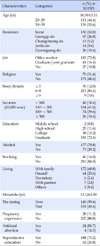Abstract
Purpose
The purpose of this study was to construct and test a structural equation modeling on the reproductive health behavior of single women with sexual experiences. This study employed Ajzen's Theory of Planned Behavior (TPB).
Methods
The data were collected after receipt of consent from 250 single women with sexual experiences, and analyzed using SPSS 18.0 and AMOS 18.0.
Results
Model fit indices for the hypothetical model were suitable for the recommended level: x2=362.407, RMR=0.065, RMSEA=0.070, GFI=0.867. TLI=0.927, CFI=0.938, IFI=0.939, and x2/dF=2.237. Intention showed direct effect with the biggest effect being on reproductive health behavior. Attitude, subjective norm and perceived behavioral control were found to have a direct effect on intention. Among them, perceived behavioral control revealed the largest influence.
Figures and Tables
Table 1
General Characteristics of Participants

Table 2
Effects of Hypothetical Model

Summary Statement
▪ What is already known about this topic?
Reproductive health is a broad concept that includes sexual health with health problems associated with the reproductive organs. First sexual intercourse is happening at a younger age and age for first marriage is at a later age. There are many factors that interfere with reproductive health, including artificial abortion, sexually transmitted diseases and unmarried pregnant women.
▪ What this paper adds?
The theory of planned behavior is a suitable model in explaining the reproductive health promoting behavior of single women with sexual experience. Intention was the biggest factor with direct effect on the behavior of single women with sexual experience. In terms of factors having a direct effect on intention, “attitude”, “subjective norm” and “perceived behavioral control” were identified. Among them, “perceived behavioral control” revealed the largest influence.
▪ Implications for practice, education and/or policy
Strategic plans for educational and intervention programs should be aimed to encourage single women to engage in reproductive health behavior.
References
1. UN ICPD(International Conference on Population and Development). Chapter VII. Reproductive rights and reproductive health. In: Programme of action adopted at the International Conference on Population and Development [internet]. Geneva: UN;1994. cited 2015 May 20. Available from:http://www.unfa.org/icpd/icpd-programme.cfm#ch7.
2. Jo HY, Kim YH, Son HM. Development of a scale to measure reproductive health promoting behavior of undergraduates. Korean J Health Educ Promot. 2014; 31(5):29–43.

3. Ahn S, Park I, Han JS, Kim TI, Kwak MS, Chung HS. Health behaviors, reproductive health history, and sexual behaviors of college students. Korean J Women Health Nurs. 2008; 14(3):205–212.

4. Shin KR, Park HJ, Bae KE, Cha C. Sexual behavior, health risk behavior related to reproductive health and sexual experiences among Korean college students. J Korean Acad Adult Nurs. 2010; 22(6):624–633.
5. Ahn S, Cho KM. Personal hygiene practices related to genito-urinary tract and menstrual hygiene management in female adolescents. Korean J Women Health Nurs. 2014; 20(3):215–224.

6. Hwang SW, Chung CW. Contraception behavior and related factors in unmarried female and male. Korean J Women Health Nurs. 2011; 17(1):77–87.

7. Kim YJ. A predictive model for safer sexual behavior among Korean university students: based on the theory of planned behavior [dissertation]. Seoul: Yonsei University;2013. 126.
8. Chambers MK. A conceptual model of sexual health practices of older adolescent College Women [dissertation]. Austin: The University of Texas;2003.
9. Ministry of Health and Welfare. The third health plan in 2011-2020 [internet]. Seoul: Ministry of Health and Welfare;2011. cited 2015 June 10. Available from:http://www.mw.go.kr/front_new/jb/sjb030301vw.jsp?PAR_MENU_ID=03&MEN_ID=0319&CONT_SEQ=257824&page=1.
10. Hwang NM. Future directions of maternal and child health policy for healthy start in life. Health Welf Policy Forum. 2008; 141:5–19.
11. Choi MS, Ha NS. A study on knowledge, attitude, and experience in sex and sexual autonomy of college students. Korean J Women Health Nurs. 2004; 10(4):318–330.

12. Kim J, Han SH. Health status, reproductive health problems, and the degree of prenatal management in married working women. Korean J Women Health Nurs. 2004; 10(3):226–234.

13. Kim H, Hong YS. Attitude to reproductive health, value of marriage and children of university students. J Korean Soc Health Educ. 2013; 14(1):13–24.
14. Pinar G, Taskin L. The efficiency of sexual health and reproductive health training program developed for university youth. Gülhane tıp dergisi. 2011; 53(1):1–8.
15. Hwang SW, Chung CW. Structural equation modeling on contraception behavior of unmarried men and women in Korea: gender difference. J Korean Acad Nurs. 2014; 44(2):159–169.

16. Hur TK, Han M, Kim YS. Gender differences of risk-taking decisions in sexual behaviors: condom use and theory of planned behavior. Korean J Woman Psychol. 2001; 9(3):69–87.
18. Yu JP. Structural equation modeling concepts and understanding. Seoul: Hannarae;2012. p. 568.
19. Lee IS, Park EH, Lee JJ. A survey of attitude toward sex of unmarried women in south korea. Korean J Obstet Gynecol. 2006; 49(1):157–167.
20. Lee SH, Chon MY. Undergraduate students' sexual behavior and influencing factors: an analysis based on the theory on planned behavior. J Korean Acad Adult Nurs. 2006; 18(4):553–563.
21. Jeong SY, Kim O. The structural model of hand hygiene behavior for the prevention of healthcare-associated infection in hospital nurses. J Korean Acad Nurs. 2012; 24(2):119–129.

22. Kim GS. AMOS 18.0 Structural equation modeling analysis. Seoul: Hannarae;2010. p. 387–451.
23. Bryan A, Kagee A, Broaddus MR. Condom use among south african adolescents: developing and testing theoretical models of intentions and behavior. AIDS Behav. 2006; 10:387–397.

24. Ajzen I. Attitudes, personality and behavior. Seoul Edition. Berkshire: McGraw-Hill Education;2005.
25. Rye BJ, Fisher WA, fisher JD. The theory of planned behavior and safer sex behaviors of gay man. AIDS Behav. 2001; 5(4):307–317.
26. Swenson R. An integrated theoretical model of condom use intentions among emerging adult female college students: The health belief model and theory of Planned behavior [dissertation]. New York: the University at Albany;2007.




 PDF
PDF ePub
ePub Citation
Citation Print
Print





 XML Download
XML Download